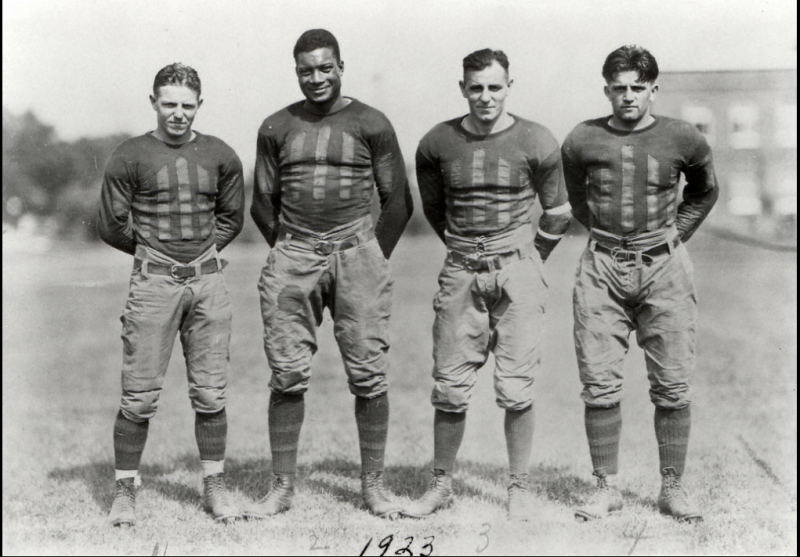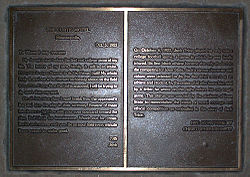

This week’s topic came to me after seeing this tweet:
I wrote about Arthur Ashe Stadium's 20th anniversary. Also dug for info on major stadiums named after black athletes https://t.co/KzfpvvKoAX pic.twitter.com/1h0IluvE7Z
— Rhiannon Walker (@InstantRHIplay) August 30, 2017
I’d never heard of Jack Trice and wanted to know more about the story. This week’s topics will focus on similar tragic stories.
John G. “Jack” Trice (1902 – October 8, 1923) was a football player who became the first African-American athlete from Iowa State College (now Iowa State University). At the time he played for Iowa State, he was also the second African-American competing in collegiate football at a major university, following Frank Holbrook who played at the University of Iowa over a decade before Trice. Trice died due to injuries suffered during a college football game against the University of Minnesota on October 6, 1923.
Trice was born in Hiram, Ohio in 1902, the son of a former Buffalo Soldier, Green Trice. As a child, Trice was active in sports and demonstrated outstanding athletic skills. In 1918, Trice’s mother sent him to Cleveland, Ohio to live with an uncle. Trice attended East Technical High School where he played football. In 1922, Trice followed five of his teammates, as well as his former high school coach, Sam Willaman, to Iowa State College in Ames, Iowa.

While attending Iowa State, Trice participated in track and football (primarily as a tackle). He majored in animal husbandry, with the desire to go to the South after graduation, and use his knowledge to help African-American farmers. His dream job was to eventually teach Southern black farmers about modern farming. In the summer before his freshman year at the age of 19, Trice married Cora Mae Starland, who was only 15. They both found jobs in order to support themselves through school. Trice also was a member of Alpha Phi Alpha fraternity, and initiated through the Alpha Nu chapter (Drake and Iowa State University).
On October 5, 1923, the night before his second college football game, Trice wrote the following in a letter on stationery at a racially segregated hotel in Minneapolis/St. Paul (the letter was later found in Trice’s suit just before his funeral):
My thoughts just before the first real college game of my life: The honor of my race, family & self is at stake. Everyone is expecting me to do big things. I will! My whole body and soul are to be thrown recklessly about the field tomorrow. Every time the ball is snapped, I will be trying to do more than my part. On all defensive plays I must break through the opponents’ line and stop the play in their territory. Beware of mass interference. Fight low, with your eyes open and toward the play. Watch out for crossbucks and reverse end runs. Be on your toes every minute if you expect to make good. Jack.
On October 6, 1923, Trice and his Iowa State College teammates played against the University of Minnesota in Minneapolis. On the night of the game, Trice got to stay at the same hotel as his teammates who stayed at the Radisson Hotel but he could not eat with them in the dining room.
In his short career at Iowa State, Trice wore the number 37.
During the second play of the game, Trice’s collarbone was broken. Trice insisted he was all right and returned to the game. In the third quarter, while attempting to tackle a University of Minnesota ball carrier by throwing a roll block, Trice was trampled by three Minnesota players. Although he claimed to be fine, Trice was removed from the game and sent to a Minneapolis hospital. The doctors declared him fit to travel and he returned by train to Ames with his teammates. On October 8, 1923, Trice died from hemorrhaged lungs and internal bleeding as a result of the injuries sustained during the game.
There was a great deal of speculation surrounding the play that resulted in Jack Trice’s death. Many of his teammates claimed after the fact that he was being targeted throughout the first two quarters because of his skin color. ISU teammate Johnny Behm told the Cleveland Plain Dealer in a 1979 interview that “One person told me that nothing out of the ordinary happened. But another who saw it said it was murder.”
Iowa State dismissed all classes after 3 p.m. on October 9, 1923 in honor of Trice.

Trice’s funeral was held at the Iowa State College’s central campus in Ames on October 16, 1923, with 4,000 students and faculty members in attendance. His casket was draped in cardinal and gold (Iowa State’s school colors) before he was buried.
As a result of his death, ISU did not renew their contract to play against Minnesota after the 1924 game. They would not play again until 1989.
In 1973, Jack Trice’s legacy was renewed and a promotion began to name Iowa State’s new stadium after him. In 1974, Iowa State University’s student body government voted unanimously to endorse this effort. In addition, the Jack Trice Stadium Committee compiled more than 3,000 signatures from supporters. However, an Iowa State University ad hoc committee voted to advise then-Iowa State University President W. Robert Parks to name the stadium “Cyclone Stadium.”
In 1984, the stadium was named Cyclone Stadium and the playing field was named “Jack Trice Field.” The ISU student body government, wanting to do more to honor Trice, raised money to erect a statue of Trice in 1987. Due to the persistence of the student body government, students, alumni, faculty and staff, and other supporters (including public figures such as Paul Newman, Hubert Humphrey, and Nikki Giovanni), the football stadium at Iowa State University was finally named Jack Trice Stadium in 1997. Jack Trice Stadium is currently the only Division I stadium or arena to be named after an African-American.
Though the statement is disputed, Jack Trice is believed to be the innovator behind the “shovel”, “shuffle”, shuttle” or “Utah” pass, a short forward pass generally to the running or up back behind the line of scrimmage. According to legend, Trice conceived the concept and presented to coach Sam Willaman. When Willaman attempted the play in a game against Drake later that year, the ball was dropped and the official incorrectly called it a fumble. The play was not used again and disappeared from college football until it was resurrected by Jack Cortice at the University of Utah in 1957. The play was made infamous by sportscasters Keith Jackson and Al Michaels who continually referred to it as the “Utah” pass.

In 2015, the story of Jack Trice was being shopped around to movie studios with the hopes that a film is made. A successful stage play debuted in 2010.
